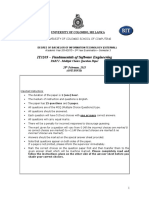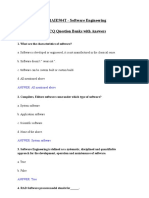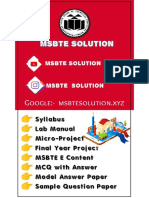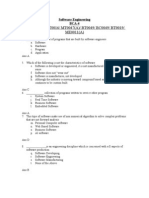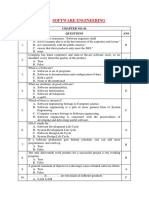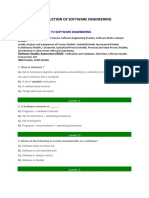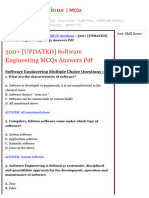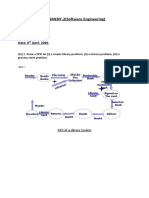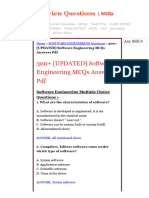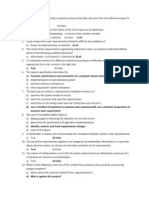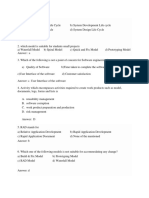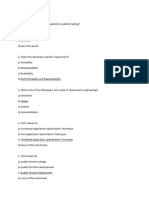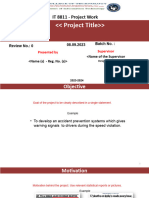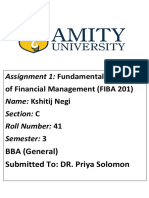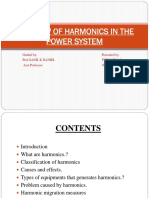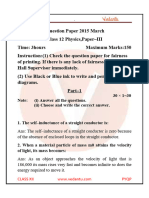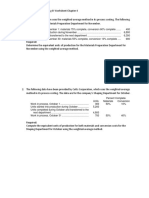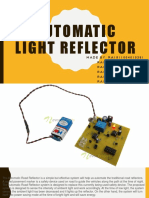302- Software Engineering
1. Software means ______.
a) a.Collection of programs only
b) Collection of data only
c) Collection of programs, data structure and associated documentation
d) None of the above
2. Pick the odd one out.
a) Windows XP
b) Flipcart.com
c) RAM
d) ERP
3. Which of the following is/are the characteristics of Software?
(i) The software is engineered or developed, it is not manufactured in classical sense.
(ii) The Software doesn't wear-out.
(iii) Software is tangible whereas hardware is not tangible.
a) (i) Only
b) (ii)Only
c) Both (i) and (ii)
d) All
4. The initial failure rate of _______ is high.
a) Both software & hardware
b) Only software
c) Only hardware
d) Neither software nor hardware
5. The failure rate of software spikes due to _______.
a) Errors in software
b) Change in software
c) Environmental maladies
d) Cost
6. Software doesn't wear-out, but it does _________.
a) Emerge
b) Become useless
c) Deteriorate
d) Reengineered
Page 1
�7. The base that supports the software engineering is a ____________ layer.
a) Tools
b) Methods
c) Process
d) Quality focus
8. Which of the following is/are the goals of software engineering?
(i) Reduce cost and time for software development.
(ii) Developing high quality software.
a) (i)Only
b) (ii)Only
c) Both (i) and (ii)
d) None of these
9. Which of the following is correct order for generic framework activities?
a) Development, Definition, Support
b) Definition, Development, Support
c) Support, Definition, Development
d) Definition, Support, Development
10. Adding new features in the existing software is known as ____________.
a) Prevention
b) Enhancement
c) Correction
d) Adaption
11. Waterfall Process Model can be used for software development when the ________
a) Requirements are not known
b) New system is to be developed
c) Requirements are well understood
d) None of the above
12. Which of the following model is appropriate to accommodate changes?
a) Waterfall model
b) Prototype model
c) Both a & b
d) None of the above
13. Prototype model is ________.
a) Iterative
b) Linear
c) Sequential
d) None of the above
Page 2
�14. The notation “Define before Design and Design before Code” is justified for which model?
a) Prototype model
b) WINWIN model
c) RAD model
d) Waterfall Model
15. ___________ is the most critical factor affecting the quality of the software.
a) Analysis
b) Design
c) Coding
d) Testing
16. The _________ model helps software engineer and customer to better understand the requirements.
a) Prototype
b) Waterfall
c) Rapid application development
d) Incremental model
17. Which model suggests a sequential approach to software development?
a) Prototype model
b) Waterfall Model
c) WINWIN model
d) RAD model
18. QFD stands for:
a) Quality Function Deployment
b) Quality Function Development
c) Quality Financial Deployment
d) Quick Function Deployment
19. The absence of ___________________ type of requirements in QFD will be a cause of dissatisfaction.
a) Normal
b) Expected
c) Exciting
d) None of these
20. Which of the following is the core of the analysis model?
a) ER-Diagram
b) Data Dictionary
c) Data Flow Diagram
d) Control Diagram
Page 3
�21. A description of each function in Data Flow Diagram is presented by ________________.
a) Data Object Description
b) Control Specification
c) Process Specification
d) Data Dictionary
22. Level ‘0’ DFD is also called __________________.
a) Context level DFD
b) Conceptual level DFD
c) All of the above
d) None of the above
23. In DFD external entity is represented using ____________ symbol.
a) Rectangle
b) Circle
c) Arrow
d) Parallel lines
24. How many bubbles (process) present in the level ‘0’ DFD.
a) 0
b) 1
c) 2
d) 3
25. ___________________ Component of SRS specify the expected behavior of the system.
a) Functional Requirements
b) Performance Requirements
c) Design constraints imposed on an implementation
d) External interfaces
26. Which of the following is not a characteristic of an SRS?
a) Complete
b) Correct
c) Ambiguous
d) Traceable
27. Which of the following model(s) is/are iterative?
a) Prototype
b) Incremental
c) Spiral
d) All of the above
Page 4
�28. Which of the following is not part of design model?
a) Data design
b) Procedural Design
c) E-R Diagram
d) Architectural design
29. Which of the following is not a design principle?
a) The design should not suffer from tunnel vision.
b) The design should not be traceable to analysis model.
c) The design should not reinvent the wheel.
d) The design should exhibit uniformity and integration.
30. Which of the following formula is true with regards to modularity?
a) E(P1 + P2) > E(P1) + E(P2)
b) E(P1 + P2) < E(P1) + E(P2)
31. If number of modules increases then the total software cost increases due to cost of _____________.
a) Development
b) Integration
c) Testing
d) Design
32. Which model address behavioral aspect of program structure?
a) Structural model
b) Framework model
c) Dynamic model
d) Process model
33. _______________is a measure of the number of modules that are directly controlled by another
module.
a) Fan-out
b) Fan-in
34. Functional independence is direct outgrowth of, _______________.
a) Abstraction, refinement and program structure
b) Modularity, abstraction and software procedure
c) Modularity, abstraction and information hiding
35. Independence is measured using which qualitative criteria.
a) Cohesion
b) Coupling
c) Both
d) Neither of them
Page 5
�36. Which of the following coupling is best?
a) Control
b) External
c) Content
d) Data
37. ______________ is the strongest cohesion.
a) Sequential
b) Functional
c) Coincidental
d) Procedural
38. If and while statement in some programming language is an example of ______________ abstraction.
Data
a) Procedural
b) Control
39. ______________ and _____________ are the input for data design from analysis model.
a) DFD, DD
b) DD, STD
c) ERD, DD
d) DFD, SPEC
40. Internal program logic is tested using ___________ testing technique.
a) White box
b) Black box
c) Red box
d) None of these
41. Testing is a process of executing program with the intent of _________ errors with __________
amount of time and efforts.
a) Solving, maximum
b) Finding, maximum
c) Solving, minimum
d) Finding, minimum
42. Exhaustive testing is possible. True OR False
a) True
b) False
43. What is the cyclomatic complexity of the flow a graph if number of edges are 11 and nodes are 7?
a) 6
b) 7
c) 8
d) 9
Page 6
�44. Which of the following is not a control structure testing?
a) Condition testing
b) Data flow testing
c) Basic path testing
d) Loop testing
45. Which testing technique focuses on functional, performance and behavior requirements of the
software?
a) White box
b) Black box
46. Which of the following is/are black box testing techniques?
a) Equivalence Partitioning
b) Boundary Value Analysis
c) Cyclomatic Complexity
d) Both (a) and (b)
47. Validation testing refers which stage of the SDLC?
a) Code
b) Design
c) System Engineering
d) Requirement Analysis
48. Verification means ________.
a) “Are we building product right?”
b) “Are we building right product?”
49. The purpose of integration testing is the construction of __________.
a) Design
b) Program structure
c) Abstraction
d) Partitioning
50. Alpha testing is conducted at ___________ side by ____________.
a) Developer, customer
b) Developer, end user
c) Customer, end user
51. For real time and embedded software, ___________ testing is more important.
a) Security
b) Performance
c) Stress
d) Recovery
Page 7
�52. The ratio of the Pareto principle is _________.
a) 20:80
b) 80:20
c) 60:40
d) 50:50
53. Unit testing is ____________ oriented.
a) White box
b) Black box
54. The ________________ is the process of using new system and retiring the old system.
a) Design
b) Coding
c) Testing
d) Changeover
55. Running both old and new system at the same time for some period of time is known as ___________
type of conversion / changeover.
a) Direct Conversion
b) Parallel Conversion
c) Gradual Conversion
d) Pilot Conversion
56. In ________________ conversion method, a working version of the system is implemented in one part
of the organization such as in a particular department or some. When the system is deemed complete it
can be installed throughout the organization.
a) Direct Conversion
b) Parallel Conversion
c) Gradual Conversion
d) Pilot Conversion
57. Which of the following is not the method of system conversion?
a) Indirect method
b) Parallel-system method
c) Dual system or phase-in method
d) Pilot approach method
58. UML stands for
a) Uniform Modeling Language
b) Unified Modeling Language
c) Universal Modeling Language
d) Unique Modeling Language
Page 8
�59. The _______ relationship is used when a chunk of behavior is similar across more than one use case,
and you don’t want to keep copying the description of that behavior.
a) include
b) extend
c) communicate
d) None of the above
60. The _______ relationship is used to show that a part of a use case is optional, or potentially optional,
system behavior. .
a) include
b) extend
c) communicate
d) None of the above
61. The ___________ symbol is used to represent actor in the use-case diagram.
a) Stickman
b) Ellipse
c) Arrow
d) Rectangle
62. The ellipse symbol in the UML use-case diagram represents ________.
a) Actor
b) Use-case
c) Association
d) System boundary
63. In UML class diagram, the class is represented using rectangle divided into maximum _________
compartments.
a) 2
b) 3
c) 4
d) 5
64. Parts of a module are grouped because the output from one part is the input to another par. This
statement is true for ____________ type of cohesion.
a) Procedural
b) Communicational
c) Sequential
d) Functional
Page 9
�65. Google Assistant belongs to ____________ software.
a) System
b) Business
c) Artificial Intelligence
d) Web-based
66. In DFD, which symbol is used to show an external entity?
a. Arrow
b. Circle
c. Pentagon
d. Rectangle
67. FAST stands for
a. Facilitated Application Software Technique
b. Functional Application Software Technique
c. Facilitated Application Specification Technique
d. None of These
68. The process of developing a software product using software engineering principles and methods is
referred to as
a. Software myths
b. Scientific Product
c. Software Development
d. None of above
69. Which of the following is a tool in design phase?
a. Abstraction
b. Refinement
c. Information Hiding
d. All of these
70. The major shortcomming of waterfall model is :
a. the maintenance of system
b. The system testing
c. The difficult in accommodating changes after feasibility analysis
d. The difficult in accommodating changes after requirement analysis
71. What is Software requirement?
a. It is nothing but customer need
b. it is specification that customer wants in the proposed software
c. it is minimum functionality of the software
d. it is used for testing
Page 10
�72. What is full form of SRS?
a. Software Readiness system
b. Software Requirement Specification
c. Software Repair and Simplification
d. Software Remedy and Specification
73. What is questionnaire?
a. It is list of requirements
b. It is list of wants
c. It is list of questions/queries
d. None of these
74. The relationship of data elements in a module is called
a. Coupling
b. Modularity
c. Cohesion
d. Granularity
75. Which level of DFD highlights the system as a whole?
a. First Level
b. Context Level
c. Second Level
d. None of these
76. Project risk factor is considered in which model
a. Spiral Model
b. Waterfall Model
c. Prototyping Model
d. None of the above
77. A desirable property of module is
a. Independency
b. Low cohesion
c. High Coupling
d. Multifunctional
78. There are different phase available in SDLC. Find out which phase is not available in software life cycle?
a. Coding
b. Testing
c. Maintenance
d. Abstraction
79. Applications software
a. is used to control the operating
b. Includes programs designed to help programs
c. Performs a specific task for computer users
d. None of these
Page 11
�80. Software does not wear-out in the traditional sense of the term, but software does tend to deteriorate
as it evolves, because :
a. Software suffers from exposure to hostile environments
b. Multiple change requests introduce errors in component interactions
c. Defects are more likely to arise after software has been used often
d. Software spare parts become harder to order.
81. Which of the following terms describes testing?
a. Finding broken code
b. Evaluating deliverable to find errors
c. A stage of all projects
d. None of above
e.
82. What are the different levels of Testing
a. Integration Testing
b. Unit Testing
c. System Testing
d. All of Above
83. Cyclomatic complexity is
a. White-box Testing
b. Black box Testing
c. Grey box Testing
d. All of the above
84. __________is not suited to accommodate any change.
a. Spiral Model
b. Prototyping Model
c. Incremental Model
d. Waterfall Model
85. Which of the following techniques emphasizes breaking large and complex task into successively
smaller sections?
a. Object Oriented Programming
b. Micro Programming
c. Partitioning
d. Abstraction
Page 12

